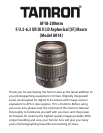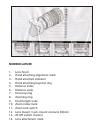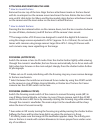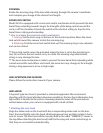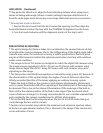
LENS HOOD (Continued)
** Pay particular attention to align the hood attaching indexes when using zoom
lenses including wide-angle (35mm or wider) settings. Improper attachment of a
hood for wide-angle zoom lenses may cause large shadowed areas in your pictures.
* Stowing lens hood on the lens
1. Reverse the lens hood. Point the lens toward the opening, and then align the
hood attachment mark on the lens with the (TAMRON O) alignment on the hood.
2.Turn the hood clockwise until the alignment mark is at the top to set it.
PRECAUTIONS IN SHOOTING
* The optical design for this lens takes into consideration the various features of digi-
tal single reflex cameras. However, due to the configuration of the digital single reflex
cameras, even when the autofocus accuracy is within specifications, the focal point
may be a little forward or behind the optimum point when shooting with autofocus
under some conditions.
* The image circles of Di II lenses are designed to match the digital SLR cameras using
the image sensors equivalent to APS-C. Do not use Di II lenses with cameras using
image sensors larger than APS-C. Using Di II lenses with such cameras may cause
vignetting on the image.
* The Tamron lens described here employs an internal focusing system [IF]. Because of
the characteristics of this optical design, the angles of view at distances other than
infinity are wider than that of the lenses applying an ordinary focusing system.
* When the built-in flash on the camera is used, adverse photographic phenomena
such as corner illumination fall-off or vignetting at the bottom part of the image may
be observed.This is due to the inherent illumination of the coverage of the built-in
flash, and/or the relative position of the flash to the edge of the lens barrel which
causes shadows on image. It is strongly recommended to use a suitable separate flash
unit provided by the camera manufacturer for all flash photography.
* Do not forcibly turn the focusing ring when the lens in set in AF mode. Doing so
could damage the lens and/or camera.
* Certain camera models may indicate the maximum and minimum aperture values
of the lens as approximate numbers.This is inherent to the design if the camera and
not an indication of error.



